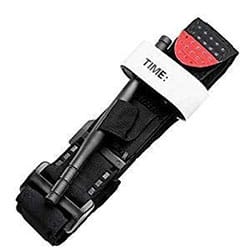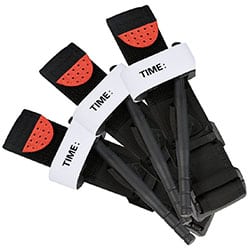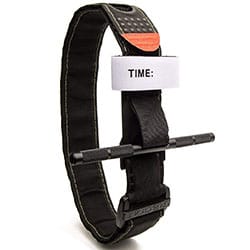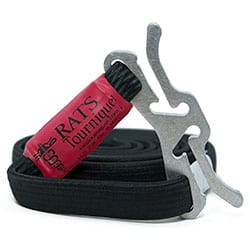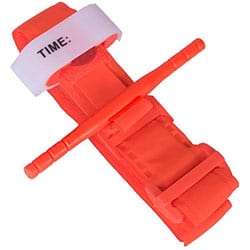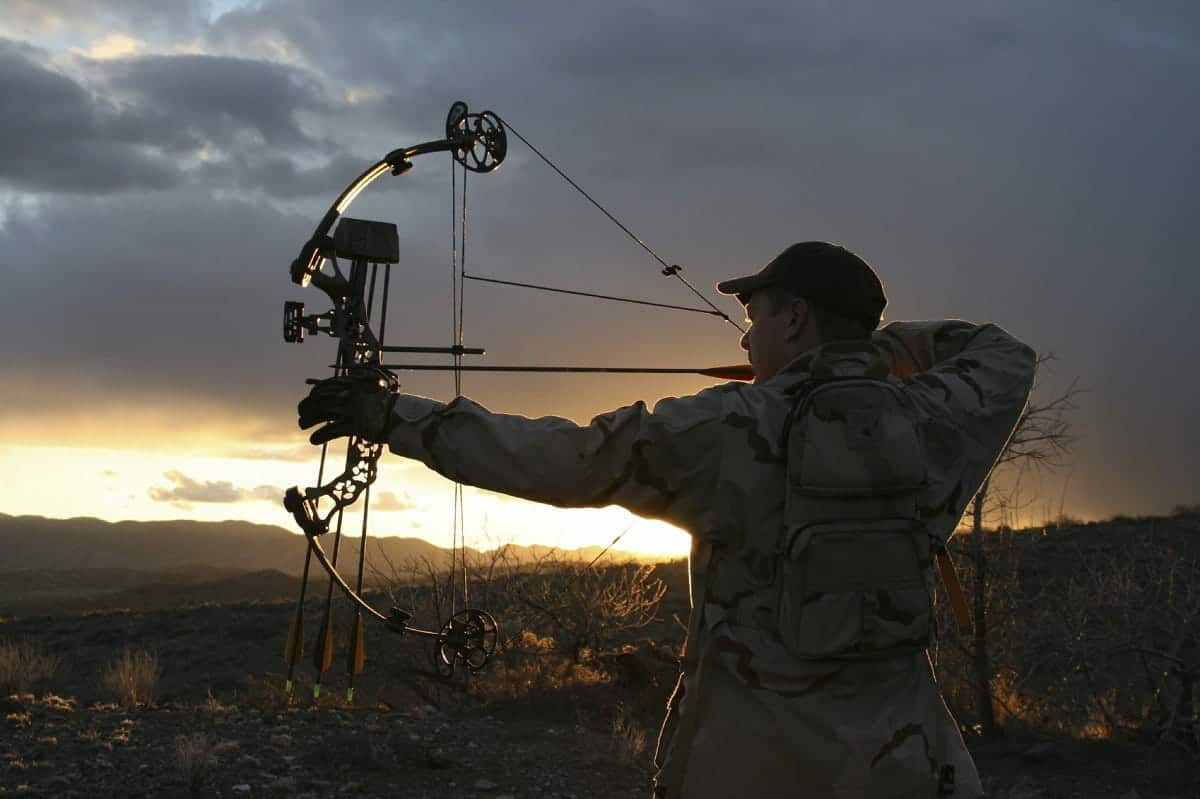Today the tourniquet is used for a variety of life-saving reasons and is a must piece of emergency equipment for rescue workers, forward deployed military, EMTs, climbers and yes, homeowners.
The basic idea of preventing blood flow in one part of the body to save either life or limb goes back to our prehistoric ancestors. During medieval times the idea of the tourniquet underwent a slight revision and became primarily a tool to constrict blood flow in order to facilitate amputations. During the 18th century a French surgeon named Jean Louis Petit invented a modified version of this ancient device and gave it the name ‘tourniquet’. The word is derived from the word ‘turnstile’ due to the turning motion of the windlass.(1)
Below are the 10 best tourniquets on the market today.
1. Softt-W 1.5 Tourniquet

The Softt-W 1.5 Tourniquet features a heavily knurled metal windlass rod that makes applying the device in an effective way very easy. All that texturing really comes in handy if you need to use it in less than ideal conditions. So this is a great tourniquet for forward deployed forces, mountain rescue teams and ski patrols. Or to have on a sailboat if you’re into long distance sailing.
There’s also a safety set screw that allows you to lock down that metal windlass rod once you find the right pressure. Once in place the Softt-W 1.5 is not going to come loose until you want it to. It’s hard to find fault with this device. It’s easy to deploy in any conditions, provides a stable, secure hold and is built to last.
2. SWAT-T Tourniquet
The SWAT-T Tourniquet has both its fans and its detractors. Fans love the wide band, the one-handed application and the way it can be used as both a pressure bandage and tourniquet. Detractors claim it’s not an effective tourniquet because it’s too wide and you can’t screw it down as there’s no windlass. Our testing indicates the truth lies somewhere in the middle.
It is a great pressure bandage and should be in any decent emergency kit for the reason alone. It will also work as an effective tourniquet as long as you have plenty of room above the wound and the person is thin to normal weight.
3. Salomon’s Products Military Combat Tourniquet
This military style tourniquet has a familiar design that immediately reminds one of the best known tourniquet brands. And that’s fine. If you’re going to copy something copy something good. It’s features true one-handed application with a nice long band (39 inches) and composite buckles that resist cold weather damage.
The strap has a bright red tip for easy guidance in the dark and the aluminum windlass is very tough. There’s a nice wide area to jot down the application time and the whole thing is light and affordable.
4. SZCT Klink Portable Tourniquet
The SZCT Klink Portable Tourniquet is well-made, reliable and generally easy to install. It features a bright red tip that facilitates threading in the dark and locks in place effectively once installed. The buckles are fashioned from composite materials that resist cracking or breaking even in cold weather conditions.
It’s also long enough to fit around all but the absolute largest legs. And it’s affordable, with this 3 pack costing about the same as a large pizza. If we have an issue with the SZCT Klink tourniquet it’s the lack of knurling on the windlass. Yeah there are a few grooves to facilitate things but not enough to make a meaningful difference in extreme conditions. Therefore it might not be the best tourniquet for forward deployed troops or mountain rescue teams who are often forced to operate in terrible weather.
5. Recon Medical Mil-Spec Kevlar Metal Windlass
Recon Medical is back for one last appearance on our list. Their Mil-Spec tourniquet features kevlar stitching and an aluminum windlass that will withstand much greater forces than plastic. The buckles are a composite material that won’t break in extreme cold weather.
Making this a great choice for ski patrols and mountain rescue teams. About the only downside we found was that adjusting the strap to get the right fit was not effortless. But it wasn’t a deal breaker either. In general it’s a tough, fairly easy to use, reliable tourniquet with a big space for writing down the application time and a no-curl, bright red tip.
6. RATS Tourniquet w/ EDC Belt Sleeve Holder
The RATS Tourniquet takes a very different approach to cutting off blood flow. Unlike the rest of our tourniquets this one features a narrow strap that’s designed to be wrapped around the leg several times and then fixed into the metal pinch.
It’s undoubtedly easy for one person to apply to another. Or for one person with two fully functioning arms to apply. Those needing one-handed application are going to want to look elsewhere, however. Still, under the right conditions it can be applied quickly and effectively and it comes in a variety of highly visible colors. No place to write down the time though.
7. Recon Medical Orange Tourniquet Gen 3
The Recon Medical Orange Tourniquet Gen 3 is an easy to use piece of potentially life-saving equipment. It features Kevlar stitching, a single route recon buckle, an aluminum windlass and the company’s trademark finger hole in the strap to allow for a nice firm set even in the nastiest conditions.
That aluminum windlass is far more dependable than plastic which makes this an excellent choice for forward deployed troops, mountain rescue teams and EMTs. Recon Medical also provides a large area to scribble down the time you applied the tourniquet. This helps prevent the device from remaining on too long. Which, as we’ll see below, could cause complications. Affordable, reliable and easy to use it’s an all around winner.
8. Eyocean Tourniquet
The Eyocean Tourniquet is available in black, blue and red and features a plastic windlass, plenty of Velcro to hold it fast and an aggressive pinch teeth buckle. There’s a large area to write down the application time and, because the windlass is plastic, this is a very light tourniquet.
We were able to install the tourniquet using one hand. But it takes some practice. The band is 37 1/2 inches long, which is big enough for 99% of humans and the buckles are fashioned from a cold-resistant composite. A good choice to have in the home emergency kit or in the car in case the unthinkable happens.
9. NAR CAT Tourniquet Gen 7
The combat application tourniquet or CAT is a popular tourniquet used by EMTs, ski patrols and more. It features rock-solid build quality and is quickly installed and locked down with one hand if necessary. It’s not the cheapest tourniquet out there but it’s not going to let you down under any circumstances. The NAR CAT Gen 7 tourniquet features a wide Velcro strip with a bright red tip for confident threading in low light.
It’s also one of the lightest tourniquets on this list. And that brings us to the only real downside here. The reason it’s so light is that the windlass is made of plastic, not metal. So while it’s tough, it isn’t going to measure up to metal when the pressure is really on. Mostly for civilian use and perhaps hospital staff.
10. Recon Medical Tourniquet
There are a few big names in the tourniquet business and Recon Medical is perhaps the biggest. They produce a full line of affordable, easy to use tourniquets like this one that fit easily into your emergency kit and can be deployed in seconds when need be. This Recon Medical Gen 3 Mil-Spec tourniquet features an assisted occlusion strap with finger hole that allows you to bring positive force to bear even in sloppy, challenging conditions.
There’s an aluminum windlass, kevlar stitching and a rock-solid buckle that keeps the device in place. There aren’t a lot of changes from the previous iteration of this tourniquet. Basically, it just has a more formidable feel to it. And at this price that’s enough to recommend it.
FAQs
What is a Tourniquet?
As we mentioned in the opening the tourniquet has been around in one form or another since prehistoric times. There’s evidence that Stone Age people employed the technique of cutting off blood flow to save lives many thousands of years ago. Although just what they did once they prevented the patient bleeding out remains something of a mystery. Nonetheless, the tourniquet was a well known and (apparently) a widely practiced way to try and save lives.
In the 18th century Jean Louis Petit (2), a surgeon working in Paris developed the screw tourniquet. What set it apart from existing tourniquets was its ability to be installed and released by a single individual. Early version of this tourniquet consisted of wooden parts. But later, metal was introduced. There have been various refinements of Petit’s tourniquet, but the basic design has survived and is still employed in emergency situations worldwide.
What Situations Would Call for the Use of a Tourniquet?
A tourniquet is not something that will be needed on a daily basis. Even army corpsman will only have occasional use for a tourniquet. But, should a limb injury result in a catastrophic hemorrhage a tourniquet can very much be the difference between life and death. Here are some instances when a tourniquet will be required.
- Hypovolaemic shock – Car accidents, gun accidents and other incidents can result in what’s called hypovolaemic shock (3). Hypovolaemic shock is a fancy way of saying ‘catastrophic blood loss’ and it can easily result in death. As such any concern about causing damage to a limb by using a tourniquet should be overridden by the need to prevent loss of life.
- Industrial accidents – Unfortunately, industrial accidents tend to be severe. The oil and gas and mining industries are rife with examples of catastrophic accidents (4) resulting in significant damage to limbs, as is the construction industry. It’s important for drilling sites, offshore oil platforms, all types of mines, construction sites and more to have tourniquets on hand.
- First responders – EMTs responding to serious accidents are often faced with the need to use a tourniquet in order to stop a catastrophic bleed-out. In addition, police, firefighters and others responding to the scene of a terrorist incident often find themselves faced with gruesome injuries requiring tourniquets.
- Trapped victims – In some cases, especially when it comes to car accidents, victims may be trapped in the crumpled vehicle with their injury inaccessible to direct pressure. In such cases a tourniquet might be the only way available to control bleeding whilst firefighters attempt to extricate the victim using the jaws of life (5) or other means.
Studies have shown that people in the type of situations described above have an increased chance of survival when tourniquets are judiciously applied.
What’s the Right Way to Apply a Tourniquet?
Lots of people are aware of tourniquets and what they’re used for but have little idea about how to apply them in the proper manner. The job of the tourniquet is to squeeze the artery above the injury in order to reduce or shut off blood flow. If you are involved in a situation where a tourniquet may be required just remember to call for professional help and ensure they are on the way before you apply the tourniquet. That said, here’s the right way to apply a tourniquet:
Step 1: assess the situation – In order for a tourniquet to be effective you’ll need at least 2 inches of space on the arm or leg above the wound. This is necessary because a severed artery tends to retreat toward the heart. So you need a couple of inches of ‘slack’ as it were in order to ensure you’re cutting off blood flow effectively.
Step 2: remove clothing – Wounds are often hidden under pants or shirts. Sometimes under several layers of clothing. Therefore, if at all possible, you should remove any clothing over the affected area before applying the tourniquet. Tourniquets will sometimes work when applied over clothes but their effectiveness is compromised. Still, if you have no way to remove the obstructions go ahead and apply the tourniquet anyway.
Step 3: ensure you’re using a proper width tourniquet – Today’s best tourniquets are all of sufficient width (about an inch) to ensure they cut off blood flow without cutting into skin and muscle. In cases where a professionally manufactured tourniquet is not available people sometimes use cord or wire. But this only tends to magnify problems by creating additional tissue damage. If you need to improvise use something wide.
Step 4: apply it at the proper angle – A tourniquet should always be applied at a 90 degree angle to the artery. Applying it at a more baroque angle can interfere with or reduce its effectiveness.
Step 5: tighten the tourniquet – Once installed around the leg and arm at the proper angle it’s time to tighten the tourniquet. Most of today’s best have a metallic windlass with a knurled finish that makes tightening it one-handed relatively easy. You need to tighten it enough to stop blood flow. This is going to hurt the injured person. There’s no way to avoid that. Warn them and then be resolute in tightening the tourniquet enough even though they may protest.
Step 6: lock the tourniquet in place – Most of the best tourniquets allow you to lock the windlass down once you achieve the right amount of pressure. This ensures it won’t come loose if the person moves around. It will also free you to concentrate on other things while you wait for professional help to arrive.
Step 7: take note of when you applied it – A lot of today’s best tourniquets provide you with a tab right on the device that allows you to write down the time you applied it. This will be important information for EMTs, firefighters or whoever responds to your call for help. If you don’t have any means of writing the time down make a mental note and tell the responders when they arrive.
We need to reiterate the importance of making sure, whenever humanly possible, that help is on the way before you go ahead and apply the tourniquet. This will prevent it from being in place longer than it has to be and ensure that the victim stands the best chance of a full recovery. Of course, if the victim is in imminent danger of bleeding out then go ahead and install the tourniquet. But otherwise make sure to call for professional help first.
Are There Any Risks to Using a Tourniquet?
Tourniquets should not be considered a first option. They should be employed only if it is impossible to apply direct pressure to the wound or if the blood flow is so great that extraordinary measures are called for. This is because cutting off blood flow to most of a limb could potentially lead to other serious issues. For this reason the tourniquet should also be removed as soon as it is safe to do so. The potential problems we just mentioned include:
- Ischemia – Ischemia (6) is the technical term for inadequate blood flow to bodily tissues. This can happen if a tourniquet is left in place for too long. After about 2 hours with a tourniquet in place nerve damage will start to manifest. So will damage to muscle tissue and veins. A couple of more hours and muscle damage will be irreversible. Necrosis, or tissue death, will also set in. As we mentioned above it’s important to remove the tourniquet as soon as it is safe to do so.
- Compartment syndrome – While many folks have at least some understanding of ischemia virtually no one outside of medical professionals have heard of compartment syndrome (7). But it is a risk when tourniquets are involved. In this case the ‘compartment’ is the limb; either the arm or the leg. Application of a tourniquet can raise the pressure within the limb by trapping blood and other fluids. When this happens it can result in nerve and/or muscle damage.
- Death by slow release – In an attempt to save a limb some will loosen a tourniquet incrementally over time. While the thought is honorable this incremental exsanguination (8) as it is called often leads to victims slowly bleeding out and dying.
- Reperfusion – Tissue damage caused by a lack of blood becomes a danger if the tourniquet is in place too long. Conversely, if the tourniquet has been in place long enough that lack of oxygen has caused damage to the muscle tissue reintroducing oxygenated blood – called ‘reperfusion’ (9) – can increase muscle damage rather than relieving it.
When it comes to tourniquets the by-word is ‘caution’. Only apply them when absolutely necessary and don’t leave them in place longer than necessary. A tourniquet when used properly can save an arm or a leg or even a life. But when left on too long or improperly applied the above risks come into play.
The Bottom Line
The tourniquet has been saving lives for thousands of years. Despite all the medical advances we’ve made as a species this decidedly low-tech device continues to play an important role in triage (10) situations. A tourniquet is an essential item to a first aid kit. There are two prime considerations when it comes to the application of tourniquets. One, they should not be used if direct pressure will work. And two, you should never leave one in place longer than necessary.
Should you find yourself in a situation where application of a tourniquet is necessary, follow the steps outlined above to be sure you’re installing it properly. Any of the tourniquets on our list will be important additions to an emergency medical kit. Just remember they’re the last option, not the first.

